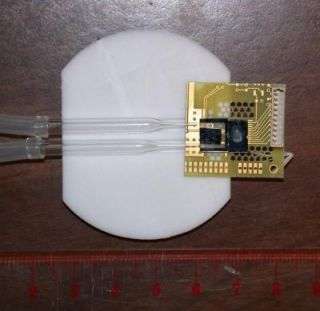'NMR on a chip' features magnetic mini-sensor

A super-sensitive mini-sensor developed at the National Institute of Standards and Technology can detect nuclear magnetic resonance (NMR) in tiny samples of fluids flowing through a novel microchip. The prototype chip device, developed in a collaboration between NIST and the University of California, may have wide application as a sensitive chemical analyzer, for example in rapid screening to find new drugs.
As described in Proceedings of the National Academy of Sciences, the NMR chip detected magnetic signals from atomic nuclei in tap water flowing through a custom silicon chip that juxtaposes a tiny fluid channel and the NIST sensor.
The Berkeley group recently co-developed this “remote NMR” technique for tracking small volumes of fluid or gas flow inside soft materials such as biological tissue or porous rock, for possible applications in industrial processes and oil exploration. The chip could be used in NMR spectroscopy, a widely used technique for determining physical, chemical, electronic and structural information about molecules. NMR signals are equivalent to those detected in MRI (magnetic resonance imaging) systems
Berkeley scientists selected the NIST sensor, a type of atomic magnetometer, for the chip device because of its small size and high sensitivity, which make it possible to detect weak magnetic resonance signals from a small sample of atoms in the adjacent microchannel. Detection is most efficient when the sensor and sample are about the same size and located close together, lead author Micah Ledbetter says. Thus, when samples are minute, as in economical screening of many chemicals, a small sensor is crucial, Ledbetter says.
Its small size and extreme sensitivity make the NIST sensor ideal for the microchip device, in contrast to SQUIDs (superconducting quantum interference devices) that require bulky equipment for cooling to cryogenic temperatures or conventional copper coils that need much higher magnetic fields (typically generated by large, superconducting magnets) like those in traditional MRI.
The results reported in the PNAS demonstrate another use for the NIST mini-sensor, a spin-off of NIST’s miniature atomic clocks. The sensor already has been shown to have biomedical imaging applications.
Citation: M.P. Ledbetter, I.M. Savukov, D. Budker, V. Shah, S. Knappe, J. Kitching, D. Michalak, S. Xu , and A. Pines. Zero-field remote detection of NMR with a microfabricated atomic magnetometer. Proceedings of the National Academy of Sciences, posted online Feb. 6, 2008.
Source: National Institute of Standards and Technology





















